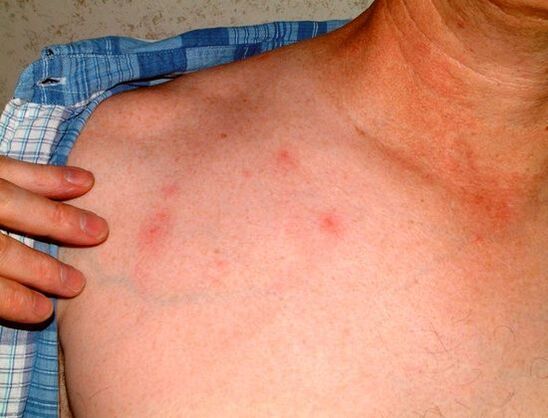
What do you know about parasitic diseases in humans? The diversity of human parasites is not limited to internal helminths.
There are several types of parasites that penetrate and live under the skin of people, causing unpleasant symptoms similar to internal parasites.
In addition, the diversity is not limited to helminths - there are ticks, insects and protozoa.
Each of them has certain symptoms and manifestations that you need to be aware of.
It is equally important to know how to get rid of parasites under the skin.
Types of skin diseases caused by parasites
What types of parasites can live under human skin? The most diverse, among them are insects, helminths, ticks and protozoa protozoa. Lesions of human skin caused by different types of parasites are differentiated as a separate type of parasitic disease.
Each group of diseases is unified by specific pathogens:
- The simplest organisms that cause protozoan skin disease.
- Ticks cause lesions on the skin.
- Insects can cause skin lesions caused by insects.
- Helminthiases develop as a result of helminth infections.

All of these human skin parasites are equally irritating and need to be diagnosed and treated. Long-neglected forms can lead to irreparable consequences ranging from blindness to death. Fortunately, it can be added that most of the list of parasites lives under the human skin, typically mainly countries with hot and humid climates.
Diseases caused by protozoa
Leishmaniasis
Leishmaniasis is caused by the simplest protozoan carrier mosquito. An infected person with leishmaniasis becomes a reservoir for further spread of the disease. After being bitten by a mosquito, which is the main host of Leishmania, a person develops cutaneous or visceral leishmaniasis. Skin leishmaniasis presents with deep ulcers or pustules and extensive skin lesions. The mucosal form of the disease leads to significant disfigurement of appearance, especially of the face. Airway edema in leishmaniasis can be fatal.
Leishmaniasis occurs in 90 countries around the world and is a very common disease in Syria, Iran, Afghanistan, Saudi Arabia, Brazil, and Peru.
Diseases caused by fleas
Demodecosis
It is a disease caused by a parasite that lives under the skin in the sebaceous glands and living hair follicles of humans. This is an extremely small mite - demodex. It is mainly localized on the eyelids, facial skin and auditory canal. Rarely - on the chest and back.
Demodex lesions cause complex acne, dermatitis, which is aggravated in spring and autumn. Skin looks red, raised blood pressure, raised rough, inflamed. The eyelid margin is often swollen, red, the eyelashes stick together, along the edge of the eyelid there is a scaly discharge, especially eyelash loss. Sometimes the disease progresses without obvious symptoms, so fleas are considered conditionally pathogenic. Usually, demodicosis is more severe in people with weakened immunity, gastrointestinal diseases, lung and metabolic disorders.
Scabies
Another common disease caused by ticks is called itchy itch. These mites gnaw at human skin passages, where they lay their eggs. The development of an adult tick comes with a complex cycle. Usually this process takes place at night, so the itching of the skin is more intense at this time. The main diagnostic symptom of the presence of parasites under a person's skin looks like small double red dots lying nearby. These are double paragraphs gnawed by a tick.

The disease is complicated by many different infections that patients try to relieve itching: streptococcal dermatitis, rash, bloody scabs around scratches, rash in the form of bloody blisters, and other skin lesions. Complications of scabies can be like urticaria, pyoderma, dermatitis, eczema, psoriasis.
Infection usually occurs through prolonged contact with an infected person (it has been shown that scabies is in skin-to-skin contact, lasting up to 30 minutes; you should not dismiss the relatively low probability of infection from shared use of scabies). household).
Diseases caused by insects
All skin diseases caused by dipterans are collectively known as myiasis.
Wolfarthiosis
The disease is caused by an insect called the wolfarth fly, which lays its larvae in the mucous membranes or wounds of the human body. The larvae destroy the tissues, releasing a special enzyme, causing severe pain, necrosis, edema, purulent discharge and necrosis of the affected tissues. They usually live in the eyes, nose, and ears. Wolf flies are common in countries with hot and temperate climates.
Diseases caused by helminths
Dirofilariasis
A disease caused by roundworms. The source of infection is domestic animals - dogs and cats. The carrier is a mosquito. After the bite, sexually mature individuals of roundworms begin to develop in the human body, as a rule, they parasitize under the human skin. Insect bites become denser, inflamed and itchy. The characteristic feature of the pathogen is the ability to move under the skin, so the disease is accompanied by a sensation of movement, crawling inside the inflamed intimate area. Sometimes a roundworm can be seen under the skin; Cases of an individual emerging from the mucous membrane of the eye are described.
Allergic reactions, fever, nausea and weakness may be accompanying symptoms.
Strongyloidiasis
The disease is caused by parasitic larvae that penetrate the human skin, so the person walks barefoot on the ground. Strongyloides are found in Georgia, Ukraine, Krasnodar, Stavropol Territory. Roundworm larvae penetrate through the skin and migrate downwards causing redness, itching of the skin and red blisters.
Treatment recommendations
General recommendations have been developed for the treatment of human diseases caused by subcutaneous parasites. The most appropriate treatment for our area is the treatment of strongyloidiasis, scabies and demodicosis. Treatment is indicated after the diagnosis of the disease and only by a specialist. Some complications and manifestations of the disease require an individual treatment.
- Trichinosis is recommended to be treated with antiparasitic drugs.
- To treat itching itching, ointments, creams and other effective remedies are used. To combat scabies, a treatment regimen and a system of precautions for contacts have been developed.
- Treatment Demodex is carried out with complex measures to strengthen the immune system, treat diseases of the gastrointestinal tract and other procedures. Ointments for the treatment of scabies are applied directly to the skin, as well as various cosmetic procedures.

Parasitic diseases of the skin require an effort to treat, so it is best to prevent infection by applying basic rules of personal hygiene. It is not superfluous to know the common symptoms associated with such diseases, so as not to come into close contact with sick people.






























